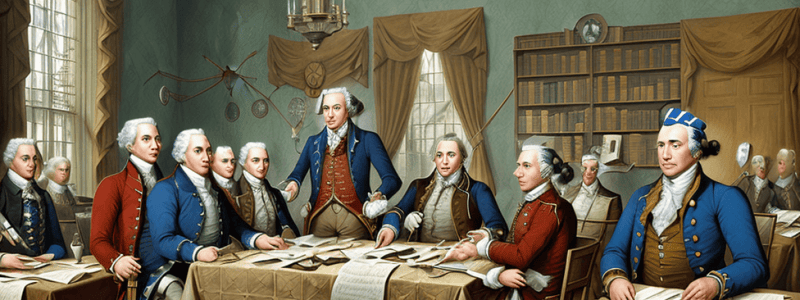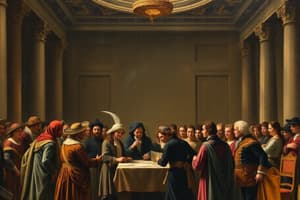Podcast
Questions and Answers
Which event resulted in the adoption of the first ten amendments to the U.S. Constitution, known as the Bill of Rights?
Which event resulted in the adoption of the first ten amendments to the U.S. Constitution, known as the Bill of Rights?
Who were the supporters of the U.S. Constitution and a strong central government?
Who were the supporters of the U.S. Constitution and a strong central government?
What was the primary crop grown in Virginia and other southern colonies?
What was the primary crop grown in Virginia and other southern colonies?
Which event led to a monopoly on tea sales in the American colonies for the British East India Company?
Which event led to a monopoly on tea sales in the American colonies for the British East India Company?
Signup and view all the answers
Who were the opponents of the U.S. Constitution, fearing a strong central government and demanding a Bill of Rights?
Who were the opponents of the U.S. Constitution, fearing a strong central government and demanding a Bill of Rights?
Signup and view all the answers
Which event was a turning point in the American Revolution, leading to France allying with the United States?
Which event was a turning point in the American Revolution, leading to France allying with the United States?
Signup and view all the answers
What was the Olive Branch Petition's purpose during the American Revolution?
What was the Olive Branch Petition's purpose during the American Revolution?
Signup and view all the answers
Which battle led to the surrender of General Cornwallis, marking the final major battle of the American Revolution?
Which battle led to the surrender of General Cornwallis, marking the final major battle of the American Revolution?
Signup and view all the answers
Who trained the Continental Army at Valley Forge, helping to turn them into a more professional fighting force?
Who trained the Continental Army at Valley Forge, helping to turn them into a more professional fighting force?
Signup and view all the answers
What was the nickname for British soldiers during the American Revolution, referring to their red uniforms?
What was the nickname for British soldiers during the American Revolution, referring to their red uniforms?
Signup and view all the answers
What was the 1st Constitution of the U.S. from 1781-1788?
What was the 1st Constitution of the U.S. from 1781-1788?
Signup and view all the answers
Who led the armed uprising known as Shay’s Rebellion in Massachusetts?
Who led the armed uprising known as Shay’s Rebellion in Massachusetts?
Signup and view all the answers
Which plan at the Constitutional Convention called for a strong central government with a bicameral legislature and representation based on population?
Which plan at the Constitutional Convention called for a strong central government with a bicameral legislature and representation based on population?
Signup and view all the answers
What was the compromise at the Constitutional Convention that created a bicameral legislature with representation based on population in the House of Representatives and equal representation in the Senate?
What was the compromise at the Constitutional Convention that created a bicameral legislature with representation based on population in the House of Representatives and equal representation in the Senate?
Signup and view all the answers
Which compromise at the Constitutional Convention counted each enslaved person as three-fifths of a free person to determine representation and taxation?
Which compromise at the Constitutional Convention counted each enslaved person as three-fifths of a free person to determine representation and taxation?
Signup and view all the answers
What is the division of government powers among the legislative, executive, and judicial branches to prevent any one branch from becoming too powerful?
What is the division of government powers among the legislative, executive, and judicial branches to prevent any one branch from becoming too powerful?
Signup and view all the answers
Which system gives each branch of government the power to limit the actions of the other branches to prevent any one branch from becoming too powerful?
Which system gives each branch of government the power to limit the actions of the other branches to prevent any one branch from becoming too powerful?
Signup and view all the answers
What do you call changes or additions made to the U.S. Constitution?
What do you call changes or additions made to the U.S. Constitution?
Signup and view all the answers
'An armed uprising in Massachusetts in 1786-1787 led by Daniel Shays, a former Revolutionary War captain, against perceived economic and civil rights injustices' - This statement best describes:
'An armed uprising in Massachusetts in 1786-1787 led by Daniel Shays, a former Revolutionary War captain, against perceived economic and civil rights injustices' - This statement best describes:
Signup and view all the answers
What was the purpose of the meeting held in Philadelphia in 1787 to address the weaknesses of the Articles of Confederation?
What was the purpose of the meeting held in Philadelphia in 1787 to address the weaknesses of the Articles of Confederation?
Signup and view all the answers
Study Notes
The Bill of Rights and the U.S. Constitution
- The adoption of the first ten amendments to the U.S. Constitution, known as the Bill of Rights, was a result of the ratification process of the U.S. Constitution.
- Federalists, who supported a strong central government, included Alexander Hamilton, John Jay, and James Madison.
The American Colonies and the Revolution
- The primary crop grown in Virginia and other southern colonies was tobacco.
- The Tea Act of 1773 led to a monopoly on tea sales in the American colonies for the British East India Company.
- The turning point in the American Revolution, which led to France allying with the United States, was the Battle of Saratoga.
- The Olive Branch Petition's purpose during the American Revolution was to attempt to reconcile with Britain and avoid war.
- The Battle of Yorktown, which led to the surrender of General Cornwallis, marked the final major battle of the American Revolution.
- Prussian military officer Friedrich Wilhelm Baron von Steuben trained the Continental Army at Valley Forge, helping to turn them into a more professional fighting force.
- British soldiers during the American Revolution were nicknamed "Redcoats" due to their red uniforms.
The Articles of Confederation and the Constitution
- The Articles of Confederation, which was the 1st Constitution of the U.S. from 1781-1788, had weaknesses that led to the need for a new constitution.
- Daniel Shays led the armed uprising known as Shay's Rebellion in Massachusetts, which was a protest against perceived economic and civil rights injustices.
The Constitutional Convention
- The Virginia Plan, proposed at the Constitutional Convention, called for a strong central government with a bicameral legislature and representation based on population.
- The Great Compromise, also known as the Connecticut Compromise, created a bicameral legislature with representation based on population in the House of Representatives and equal representation in the Senate.
- The Three-Fifths Compromise counted each enslaved person as three-fifths of a free person to determine representation and taxation.
Government and Constitution
- The system of government that divides power among the legislative, executive, and judicial branches to prevent any one branch from becoming too powerful is called separation of powers.
- The system of checks and balances gives each branch of government the power to limit the actions of the other branches to prevent any one branch from becoming too powerful.
- Amendments are changes or additions made to the U.S. Constitution.
Studying That Suits You
Use AI to generate personalized quizzes and flashcards to suit your learning preferences.
Description
Test your knowledge about the Articles of Confederation, Shay’s Rebellion, the Constitutional Convention, and the Virginian Plan, pivotal events in early U.S. history.




